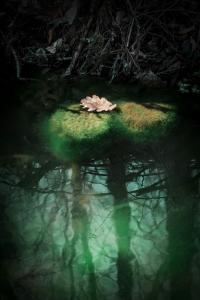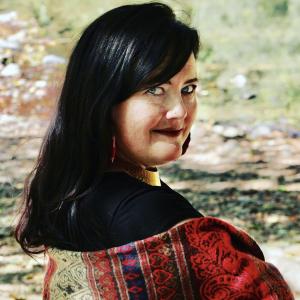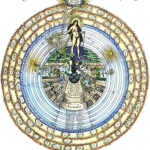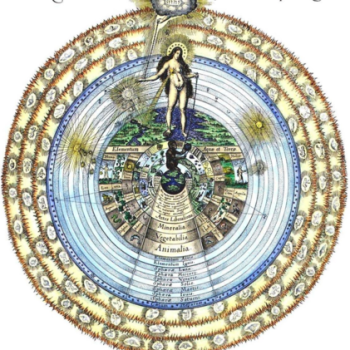Find a way to bring enchantment into your life every day
Plan time for connection

As a psychologist-magician (or psyche-magician as I like to call it) a question I often hear is, “How can I balance my magical practice with the demands of mundane daily life?” Or, “How do I balance having heightened awareness of the world’s subtle realms with the fact that I have to, like, pay bills and buy groceries?”
The reply I usually give is that we have to develop the skill of walking with a foot in both worlds, just not necessarily at the same time! Just like we have to plan to accomplish our daily tasks, or to see friends, or to enjoy fun activities, it’s a good idea to plan time weekly, ideally daily, for our spiritual self.
One way we can do this is through slowing down and simplifying our lives. By giving ourselves ample space to get things done, not over-scheduling, and planning downtime each week—essentially regulating the nervous system—unexpected moments of rapture and wonder can emerge.
As we’ve finished with the hustle and bustle of the holidays and are entering a new year, the importance of taking the time to quiet ourselves and drop down and in becomes essential. One excellent way to do this is through the cultivation of hygge.

Hygge, an antidote to over-stimulation
What is hygge, you may ask? Well, the word hygge is thought to originate from a Danish word meaning “valiant, comfort, joy.” Hygge stems from the Old Norse hyggja, which means “to think” and hugr, or hug, which means “the soul, mind, and consciousness.” So the noun hygge means something like “cozy, safe and known,” and refers primarily to a psychological state. Hygge is a sense of everyday togetherness, a pleasant and highly valued everyday experience of safety, equality, personal wholeness, and spontaneous social flow.
Hygge is something that is specifically cultivated during the winter months in Denmark and Norway—months that for folks who live in cold climates can be stark, brutal, and often life-threatening. This was also the case for many of our ancestors, where winter was traditionally a time of death and uncertainty. Remember, less than a hundred years ago, our ancestors were still troubled by questions like, “Did we store enough food to survive the winter?” “Do we have enough fuel to keep us warm?” “Will the weather be harsh and unpredictable?” “Are we going to catch a cold and die?” Will Ferrell in the Christmas Carol adaptation Spirited put it this way, “The leading cause of death [in Victorian times] was January.”
We can actually experience a kind of low-grade trauma in our nervous systems during the winter months, not only because of holiday stress or even Seasonal Affective Disorder, but also epigenetically, from the ancestral memories of when winter was a time of struggle and survival.
Hygge, then, is an antidote to winter’s uncertainty. It helps us focus on slowing down, simplifying, and getting warm and soft. And if we allow it, this can bring us into a deeper experience of ourselves, where we can commune with the quietude of our own soul or source consciousness.
Tending your depths
So let’s talk a bit more about a key attribute of hygge— that of slowing down.
Journalist Carl Honoré in his book In Praise of Slowness: Challenging the Cult of Speed has this to say,
The Slow philosophy is not about doing everything at a snail’s pace, it’s about seeking to do everything at the right speed. Savoring the hours and minutes rather than just counting them. Doing everything as well as possible, instead of as fast as possible. It’s about quality over quantity in everything from work to food to parenting.
I am by nature a very fast-paced person. Hey, I’m an Aries with Leo rising and a stellium in Gemini—so thinking and acting quickly comes easily for me. I really have to consciously cultivate slowness as a mindfulness practice. In fact, after years of rushing around over-achieving in order to avoid feeling my trauma and pain, in my forties I developed an auto-immune disease. Disease forced me to start slowing down and listening to my body more mindfully. I became really good at self-care—from the little things like getting enough sleep to the big ones like learning to say “No.”
Self-care is a hot topic these days, but contrary to the Instagram posts it’s not just about exercise or pampering. Self-care is really the art and a practice of cultivating a more centered and conscious self-awareness. Self-care can actually be the gateway to something deeper, what I call depth care or soul-tending.
But what is soul you may ask? Soul, as I’m using it here, is the deep part of your Self, the hidden or expanded part of you that maybe you aren’t even fully aware exists. It’s the part of you that holds your mystery.
We are bottomless wells of depth, we humans. To paraphrase the poet, we contain multitudes. Depth care acknowledges our vastness and seeks to put us in conversation with our own inner mystery, that font of limitless wisdom and power, the hygge within us.
A big piece of my learning in this life has been, and continues to be, about soul-tending through accessing my depths, and by asking the question, “What are the things that nourish and bolster my soul?” And what nourishes my soul—like being in nature, ritual magick, deep conversation with beloveds, spiritual study—may not be what nourishes yours.
This is where slowness becomes important. We need time and space to slow down, so that we can access and explore our depths and discover what feeds them. Because you can’t go deep if you’re moving fast.
Like a tree, it takes time to grow our depths. But once we’re really rooted and deep, we can then draw all the nourishment we need to rise up, fill out, flower, and fruit.

The magical self
And, guess what? Our depths are where our magical self lives, what in Faery Seership we call the Dreamwalker. I like to call this part of us our weird self—weird as in supernatural or otherworldly. It’s that magical part of you that can only be accessed when we drop down and into our bodies and to the Earth light that rises up from the undercountry to vitalize, rejuvenate, and restore us. You see when we go deep into ourselves, we also deepen into the Earth. And its there that we find the hidden realms, the Otherworld.
And it’s in the Otherworld that we can encounter the fair ones, also known as the shining ones, the good neighbors, or them folk. Essentially, the Faery people. But let’s be clear, I’m not talking about Tinkerbell or little gossamer sprites with wings.
According to the Faery Seership tradition, the Faery are ancient, primordial beings. They are the prehuman inhabitants of Earth who in many ways helped to shape both this planet and humanity—think the Elves in J.R.R. Tolkein’s Lord of the Rings. (In fact, Tolkien would largely base his Elven race on European Faery folklore.) My mentor, British traditional witch and founder of the House of Brigh Faery Seership Institute, Orion Foxwood describes the Faery people as “the angels that live within the land.”
And like Tolkien’s Elves, according to the folklore the Faery people crossed into other realms, the Otherworld, when humanity became too much to deal with. That Otherworld, although not geographically located, is also referred to as the underworld, or the depths.
Harnessing your magick
Ultimately, when we access our depths we touch into primordial consciousness and invite our ancient memories to awaken. It is when we touch ancient memory that the weird self begins to make its presence known. And it’s the weird self that holds your wild, wooly magick—your ability to harness the extraordinary elements of the planet and your Self to effect conscious change.
We do this, then, by slowing down and going deep. This allows us to come into contact with the living memory of Earth, the codex written in rock and tree and river. Therein lies the repository of the Fae. It is through the art of slowing down and deepening that we can foster a co-creative relationship between ourselves and all the other beings we share this planet with, both seen and unseen.
This co-creative relationship becomes one of the resources we can use to dream big dreams—collective healing dreams, world-changing dreams. For it is often our dreamwalking, weird self who brings us these dreams. And let’s face it, we all need some big dreams right now to help us envision a way out of the mess we humans seem to have gotten ourselves into!
But this can only happen if we slow down long enough to connect and listen. In fact, I would offer that cultivating hygge isn’t just for the winter months. Hygge is a good idea to practice when our lives or our world are experiencing trauma. As in, right now. So holding a practice of hygge as a way to contend with the stress of life or deal with PTSD is just good self- care!

Go slow to go big
My motto has now become: Go slow to go big.
Contrary to the adage, “go slow to go fast” I would offer that when we’re wanting to make a big change in our lives, or have a big impact in the world, or when working with big forces like the Fey, we need to slow way down. By slowing down we can cull our power and create a stable foundation that will support big shifts.
So when you feel frustrated that your projects aren’t taking off the way you’d like, or perhaps you can’t see a way through your current predicament, take heart. Perhaps you’re being invited to go slowly, so that your impact can develop a strong foundation so that you can expand. Then again, perhaps things are stalling because you’re being called to go deeper, to foster a relationship with your weird self.
Resources for slowing down
Here are a few free resources for cultivating more slowness and depth in the upcoming year. Aside from the usual things folks will tell you to do, like get out into nature and meditate (both excellent recommendations!) there are some simple things you can do, like sound therapy, that support a calmer, more depthful sense of Self.
I’m a fan of listening to the Solfeggio frequencies, specific tones of sound that help with and promote various aspects of body-mind health. These frequencies help to attune the bio-electric body towards greater cohesion and wholeness. I listen to them every night while I sleep and often when I’m meditating. You can listen to them for free on the Meditative Mind YouTube channel.
As well, tuning-fork pioneer Eileen McKusick has some fantastic free bio-field tuning resources. The human bio-field is the electromagnetic field that circulates within and around our bodies. Eileen has developed sound healing protocols that, among many other things, can help our nervous systems slow down and reconfigure. I particularly like her 144 electrical strand activation which you can download for free.
These are just a few excellent resources for helping to slow down and cultivate a sense of rest and rejuvenation. Ultimately, your depth care will look like whatever helps you find your center, brings you a sense of stillness and presence, or supports you in spelunking the mystery of your own fathomless depths.
















